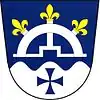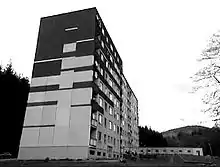Jindřichov (Šumperk District)
Jindřichov (German: Heinrichsthal) is a municipality and village in Šumperk District in the Olomouc Region of the Czech Republic. It has about 1,200 inhabitants.
Jindřichov | |
|---|---|
.jpg.webp) Paper mill | |
 Flag  Coat of arms | |
 Jindřichov Location in the Czech Republic | |
| Coordinates: 50°5′45″N 16°59′6″E | |
| Country | |
| Region | Olomouc |
| District | Šumperk |
| Founded | 1953 |
| Area | |
| • Total | 51.70 km2 (19.96 sq mi) |
| Elevation | 460 m (1,510 ft) |
| Population (2022-01-01)[1] | |
| • Total | 1,103 |
| • Density | 21/km2 (55/sq mi) |
| Time zone | UTC+1 (CET) |
| • Summer (DST) | UTC+2 (CEST) |
| Postal code | 788 23 |
| Website | www |
Administrative parts
Villages of Habartice, Nové Losiny and Pusté Žibřidovice are administrative parts of Jindřichov.
Etymology
The municipality is named after Heinrich (Czech: Jindřich) Kaiser, the second owner of the local paper mill.[2][3]
Geography
Jindřichov lies approximately 14 km (9 mi) north of Šumperk and 58 km (36 mi) north of Olomouc. The southwestern part of the municipal territory with the built-up area lies in the Hanušovice Highlands. The northeastern part of extends into the Hrubý Jeseník mountain range and includes the highest poin of Jindřichov, a contour line below the top of the Vozka mountain at 1,358 m (4,455 ft) above sea level.
The village of Jindřichov is situated in a narrow valley of the Branná River. The nearby landscape is composed of coniferous forests, steep hills, Branná floodplains and meadows.
History

Jindřichov is a young municipality founded in 1953. The municipality was created by merger of Pusté Žibřidovice with hamlets of Pleče, Pekařov, Sklenná, and with parts of Hanušovice, Vikantice and Nové Losiny.[4] In 1976 Habartov and Nové Losiny were joined to Jindřichov.[5]
Habartice is the oldest part of the municipality as it was first mentioned in 1351.[5] Pusté Žibřidovice was first mentioned in 1382.[3]
A history of Jindřichov was started in 1862 when a paper mill and an apartment building for workers were built. An investor was Joseph Abraham Winternitz, who sold it to Heinrich Kaiser in 1864.[3] The place was chosen because of the rich water source the Branná River and deep forests which can be exploited for cellulose.
A railway access with rest of Austria-Hungary was opened in 1888 as well as an access with Prussia via Głuchołazy.[6] The factory further grew up and in 1927, it had 800 employees.[3]
Economy
The economy of the village has always been connected with the paper mill, which employed more than 200 people. The factory's bankruptcy in 2008 caused a high unemployment rate, which was about 30% in 2012.[2] In 2016, the intention to convert the former paper mill into a waste sorting line was introduced.[7]
Other people are employed in forestry, agriculture and services. A part of incomes comes from tourism.
Transport
Jindřichov lies along a transregional road and a railway. Jindřichov si located on the railway line of regional importance leading from Jeseník to Ruda nad Moravou, which further continues to Zábřeh or Šumperk.
References
- "Population of Municipalities – 1 January 2022". Czech Statistical Office. 2022-04-29.
- "Nový majitel papírny v Jindřichově řekl Deníku: Výrobu chci zahájit do půl roku" (in Czech). Šumperský a jesenický deník. 2012-01-24. Retrieved 2022-01-24.
- "Pusté Žibřidovice" (in Czech). Obec Jindřichov. Retrieved 2022-01-24.
- "Jindřichov" (in Czech). Obec Jindřichov. Retrieved 2020-11-24.
- "Jindřichov" (in Czech). Jesenikyinfo.eu. Retrieved 2020-11-24.
- "Železnice na Jesenicku" (in Czech). Jesenikyinfo.eu. Retrieved 2022-01-24.
- "V papírně se chystá linka na odpady. Je to riziko, zní Jindřichovem" (in Czech). Šumperský a jesenický deník. 2016-03-15. Retrieved 2022-01-24.